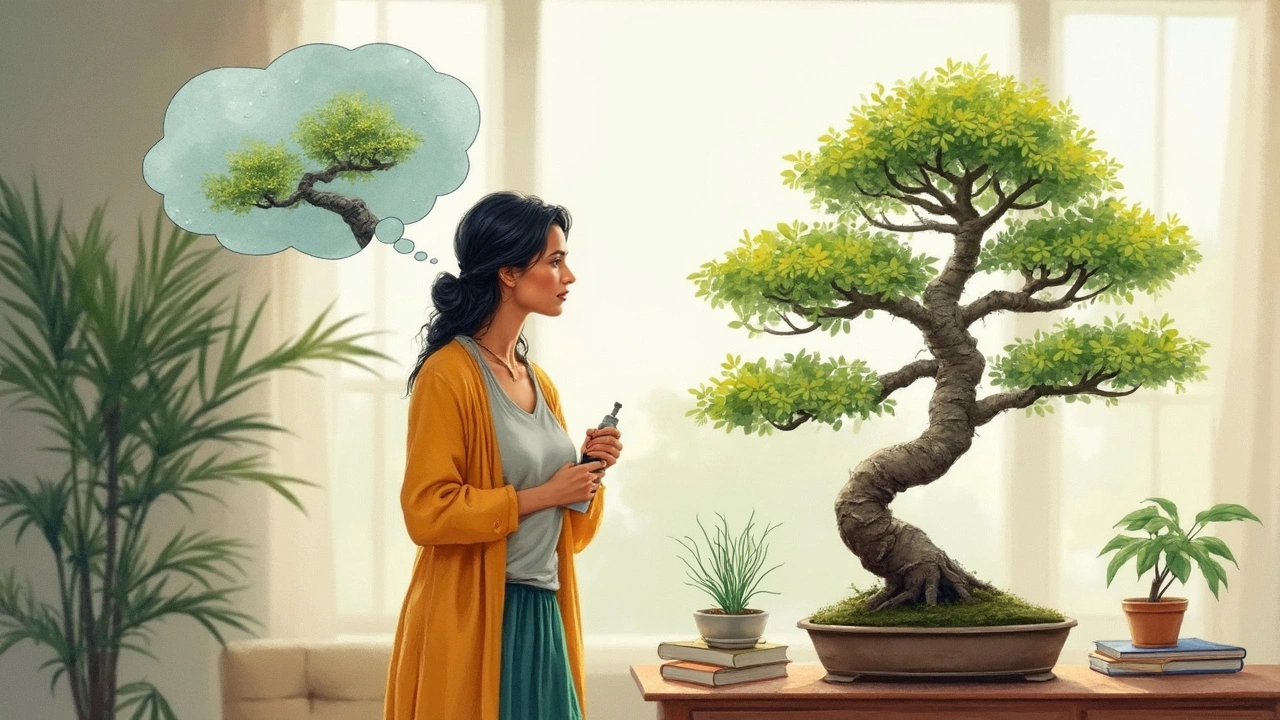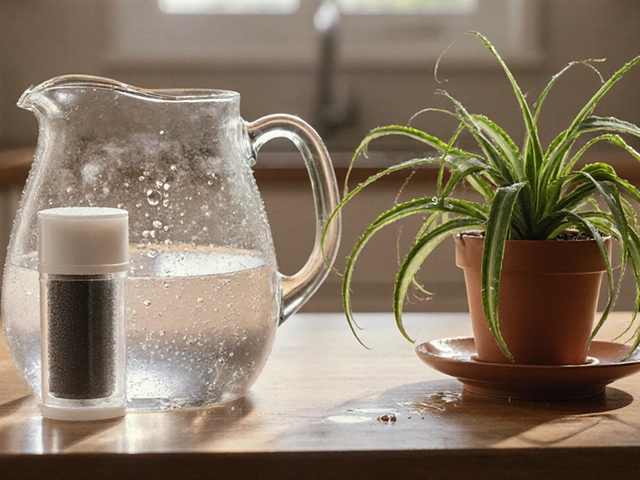Ever stood over your bonsai with a spray bottle, wondering if you’re actually helping or just wasting time? You’re not alone. People mist their bonsai like it’s the secret sauce for healthy leaves, but the truth is, it’s a bit more complicated than that.
Misting sounds simple. You spray a little water on the leaves and hope it bumps up humidity. But does it really work? Bonsai grow in all sorts of climates, and not every tree likes the same routine. Plus, that fine mist dries up fast—sometimes in just a few minutes—so your tree isn’t swimming in tropical air all day just because you misted in the morning.
If you’re aiming for lush growth or fighting off dry indoor air, there are some things you need to know before going all-in on misting. Let's unpack when it actually helps, when it’s useless, and how you can make sure your tree gets what it needs without the extra drama—or leaf spots.
- Why People Mist Bonsai Trees
- Does Misting Really Help Bonsai?
- How to Mist Properly (and When to Stop)
- Common Myths and Better Alternatives
Why People Mist Bonsai Trees
Most folks reach for that spray bottle because they’ve heard it’s good for their bonsai. The story goes like this: lots of bonsai trees, especially tropical ones like ficus and Chinese elm, are used to higher humidity than what we get at home—especially in winter when heaters dry out the air. Misting feels like an easy fix, so every morning, bonsai hobbyists fog up those tiny leaves hoping the tree will love it.
Misting isn’t just done for looks. Here’s what people are usually hoping it’ll do:
- Raise the humidity around the tree (especially for species that come from humid places)
- Keep dust off the leaves and make them look fresh
- Discourage some tiny pests, since many bugs dislike sitting water
- Give the impression of a healthy, well-cared-for bonsai
But here’s the catch: the increase in moisture from misting is pretty short-lived. Studies from indoor plant research labs show that the boost in humidity only lasts about 10-30 minutes before things go back to normal, especially in rooms with fans or AC on. So while you might feel like you’re doing a lot, the real impact might be less than you expect.
| Reason for Misting | Actual Benefit |
|---|---|
| Boost humidity | Temporary (10-30 minutes) |
| Remove dust | Works, but so does wiping with a damp cloth |
| Discourage pests | Can help briefly, but consistent treatment is better |
| Make leaves glossy | Short-lived; only cosmetic |
The main takeaway is simple: people mist because it looks and feels right, but the science says the benefits are quick and surface-level. If your goal is higher long-term humidity, you’ll need more than just the occasional mist to keep your mist bonsai routine actually useful.
Does Misting Really Help Bonsai?
If you scroll through bonsai forums or social media, you’ll see people swearing by misting. But does it move the needle for your tree’s health? The short answer: it depends on the situation and type of tree you’re working with.
Let’s talk purpose. Misting aims to boost humidity around the leaves. Here’s the catch—unless you’re misting in a sealed case or really enclosed spot, that extra humidity only lasts a few minutes. For trees that come from naturally humid environments (think tropical trees like Ficus or Serissa), extra moisture in the air can be comforting, especially when sitting indoors during winter with the radiator going.
But don’t expect long-lasting effects. Scientists have measured that misting, even with a fine sprayer, might only raise the humidity near your bonsai for 10–15 minutes; after that, it’s back to business as usual. For hardy, temperate trees like junipers or pines, misting is rarely needed and sometimes can actually cause fungus or leaf spots if you overdo it. Lots of folks have experienced issues with powdery mildew or black spots after regular misting, especially if their airflow is weak.
Some situations where misting actually helps:
- Your tree just got repotted or has weak roots and can’t suck enough water from the soil.
- You’re dealing with a super dry environment and you want to briefly help your tropical bonsai cope.
- You notice dust or bugs on the leaves—misting helps wash stuff off, but you need to follow up with good airflow.
But if you’re hoping misting will keep your bonsai happy all year, you’re probably overestimating its effect. Focus more on watering the soil correctly, using humidity trays, or running a small humidifier instead. That actually changes the air around your tree for hours, not just minutes. If you stick to using misting for quick dusting or freshening up certain tropical trees, you’ll avoid the problems others run into.
So, is misting a mist bonsai pro-tip? Sometimes—but don’t treat it as the magic cure for all bonsai problems.

How to Mist Properly (and When to Stop)
Let’s get right to it—if you’re going to mist, do it with a plan. Grabbing any old spray bottle and blasting your bonsai at random times won’t do the trick. Here’s how you actually make misting work:
- Use clean, room-temperature water. Tap water with lots of minerals can leave spots or even build up on leaves. If you see white crusty stuff, switch to filtered or distilled water.
- Mist in the morning, not at night. If leaves stay damp too long, especially overnight, you’re opening the door for mold and fungus.
- Spray lightly. You want a gentle mist, not soaking wet leaves or pools of water around the roots. Too much water can lead to root rot or leaf drop.
- Spray the undersides and tops of leaves. Pests hang out on the undersides, so get both sides if you’re fighting spider mites.
Some folks think misting is good for all bonsai, but that’s not true. Tropical varieties like Ficus or Serissa enjoy higher humidity, while pines and junipers don’t really care for it and can even end up with needle problems if you mist too much. Keep an eye on your tree—if the soil is always damp or you see fuzzy patches, cut back fast.
"Misting can help, but it’s no replacement for keeping humidity levels steady where your plant lives," says Adam Lavigne, a well-known bonsai teacher and author. "It’s a quick fix, not a long-term solution."
If your main concern is dry household air, a humidity tray under your bonsai does a better, longer-lasting job. Place pebbles in a shallow tray, fill it with water just below the surface, and rest the pot on top. The water will slowly evaporate and bump up the moisture around your tree—no spray bottle needed.
Watch for signs you’re overdoing it: limp or yellowing leaves, spots, or a musty smell. These are big red flags to stop misting and let the plant dry out. Remember, mist bonsai only when your specific tree type and room conditions actually need it.
Common Myths and Better Alternatives
People love to share bonsai advice, but a lot of what you hear about misting is just plain wrong. Let’s break down some of the biggest myths and get to what actually works.
mist bonsai is a phrase that pops up all the time online, but misting isn’t a magic fix. For example, one common myth says misting your bonsai keeps the air around it humid all day. Not true. Tests show that the extra moisture hangs around for about 10–15 minutes before it’s gone. Unless you plan to sit near your tree with a spray bottle all day, you’re not changing much for its environment.
- Myth: Misting prevents pests and diseases. Not really. Damp leaves can actually encourage fungal problems, especially if air isn’t moving well in your space. Spider mites—one of the most annoying bonsai pests—don’t mind a quick spray. They need long-lasting humidity to slow down, which misting can’t provide.
- Myth: All bonsai trees need misting. Nope. Most temperate trees (junipers, maples, pines) don’t care for it and sometimes hate it. Some tropical species appreciate a little extra humidity, but even then, it’s the room’s humidity that counts—not a single misting session.
- Myth: Misting is the best way to water a bonsai. Wrong. Misting only wets the leaves. The roots need water, not just the foliage. You have to water the soil when it dries out.
So what actually works if your bonsai needs higher humidity? Look for methods that make a real difference:
- Use a humidity tray: Fill a shallow tray with water and put gravel in it. Set your bonsai pot on the gravel (not in the water). As the water evaporates, it raises humidity right around the tree.
- Group plants together: Placing bonsai and other houseplants close to each other helps increase the local humidity. Plants naturally give off water vapor, which helps them all out.
- Use a small humidifier: If your house is especially dry (hello, winter heating), a basic room humidifier does way more than any spray bottle ever could.
- Water the soil, not just the leaves: Always water deeply, making sure moisture soaks all the way through the soil. This is what your tree actually needs for healthy growth.
Here's a quick look at how long different methods keep humidity up near your bonsai, based on actual test results:
| Method | Humidity Boost Duration |
|---|---|
| Misting | 10–15 minutes |
| Humidity Tray | Several hours |
| Grouping Plants | 6–8 hours |
| Room Humidifier | All day as needed |
If you want better results for your bonsai, skip the myths and use tried-and-true techniques. Your tree—and your peace of mind—will be better off for it.





